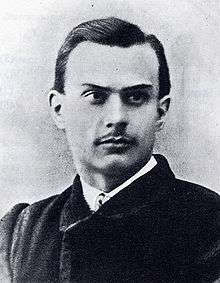Odoardo Beccari

Odoardo Beccari (16 November 1843 – 25 October 1920) was an Italian naturalist perhaps best known for discovering the titan arum, the plant with the largest unbranched inflorescence in the world, in Sumatra in 1878. This botanist is denoted by the author abbreviation Becc. when citing a botanical name.[1]
Life
An orphan from Florence, Beccari studied at a school in Lucca and the universities in Pisa and Bologna. He was the student of Ugolino Martelli. After graduating, he spent a few months at Royal Botanic Gardens, Kew, where he met Charles Darwin, William Hooker and Joseph Hooker, and James Brooke, the first rajah of Sarawak. The latter connection lead to him spending 13 years from 1865 to 1878 undertaking research in Sarawak, Brunei and other islands off present-day Indonesia, Malaysia, and Papua New Guinea. He spent most of his time in Indonesia (then Dutch East Indies) and was believed to be able to speak Malay, Javanese, and Sundanese fairly fluently. During his career he discovered many new species of plants, mainly palms (family Arecaceae).
After an expedition to Ethiopia, he made a second trip to New Guinea, this time with ornithologist Luigi Maria d'Albertis in 1872. Here they collected zoological specimens, especially birds-of-paradise and ethnographic materials.
Beccari founded the Nuovo Giornale Botanico Italiano (New Italian Botanic Journal) in 1869, and also published his results in Bolletino della Società geografica Italiana.[2] He found the Corpse Plant in 1878, located in Sumatra. In the same year, on his return to Florence, he became Director of the Botanic Garden of Florence as successor to Filippo Parlatore but resigned in the following year, 1879, after conflicts with the administration. In 1882 he married and had four sons.
Beccari's botanical collection now forms part of the Museo di Storia Naturale di Firenze. While the greatest part of Beccari’s archive is preserved at the University of Florence, some travel notes can be found in the library of the Museo Galileo.[3]
The botanical journal Beccariana from Herbarium Manokwariense, Universitas Negeri Papua (UNIPA), Manokwari, Papua Barat, Indonesia, is named after him, see external links below
Selected works
- Malesia, raccolta d'osservazioni lese e papuano (three volumes, 1877–1889).
- Nelle Foreste di Borneo. Viaggi e ricerche di un naturalista (S. Landi, Florence, 1902).
- Asiatic Palms (1908).
- Palme del Madagascar descritte ed illustrate (1912).
- Nova Guinea, Selebes e Molucche. Diari di viaggio ordinati dal figlio Prof. Dott. Nello Beccari (La Voce, Florence, 1924).
Genera and species named after Odoardo Beccari
Plants
- Beccarianthus, a genus in the family Melastomataceae
- Beccarinda, a genus in the family Gesneriaceae
- Beccariophoenix, a genus in the family Arecaceae
- Aglaia beccarii, a tree in the family Meliaceae
- Aulandra beccarii, a tree in the family Sapotaceae
- Bulbophyllum beccarii, an orchid
- Coelogyne odoardi, an orchid[4]
- Dacrydium beccarii, a conifer in the family Podocarpaceae
- Dryobalanops beccarii or Kapur Keladan, a tree in the family Dipterocarpaceae
- Haplolobus beccarii, a plant in the family Burseraceae
- Holochlamys beccarii, a plant in the family Araceae
- Lithocarpus beccarianus, a tree in the family Fagaceae
- Musa beccarii, a wild banana in the family Musaceae
- Myrmecodia beccarii, a plant in the family Rubiaceae
- Palaquium beccarianum, a tree in the family Sapotaceae
- Pritchardia beccariana, a tree in the family Arecaceae
- See also Cocos nucifera palmyrensis (Becc.), identified by Odoardo Beccari as the coconut type with the largest and most triangular (in cross-section) fruit in the world, found only at Palmyra Atoll in the Pacific Ocean.[5]
Animals
- Acanthopelma beccarii, a tarantula
- Carlia beccarii, a skink[6]
- Clinidium beccarii, a ground beetle in the family Carabidae
- Cochoa beccarii, a bird in the family Turdidae
- Conraua beccarii, frog in the family Ranidae
- Crocidura beccarii, a shrew
- Draco beccari, a "flying dragon" lizard[6]
- Emballonura beccarii, a bat in the family Emballonuridae
- Gallicolumba beccarii, a bird in the family Columbidae
- Harpesaurus beccarii, a lizard in the family Agamidae[6]
- Margaretamys beccarii, a rat in the family Muridae
- Mormopterus beccarii, a bat in the family Molossidae
- Otus beccarii, an owl in the family Strigidae
- Scopula beccarii, a moth in the family Geometridae
- Sericornis beccarii, a bird in the family Acanthizidae
- Tropidophorus beccarii, a skink[6]
- Varanus beccarii, a monitor lizard[6]
References
- ↑ Brummitt, R. K.; Powell, C. E. (1992). Authors of Plant Names. Royal Botanic Gardens, Kew. ISBN 1-84246-085-4.
- ↑
 Gilman, D. C.; Thurston, H. T.; Colby, F. M., eds. (1905). "Beccari, Odoardo". New International Encyclopedia (1st ed.). New York: Dodd, Mead.
Gilman, D. C.; Thurston, H. T.; Colby, F. M., eds. (1905). "Beccari, Odoardo". New International Encyclopedia (1st ed.). New York: Dodd, Mead. - ↑ "Inventory of Beccari's documents at the Museo Galileo library" (PDF).
- ↑ http://www.orchidspecies.com
- ↑ Joseph F. Rock (April 1916). "Palmyra Island, with a Description of its Flora". Bulletin Number 4. College of Hawaii.
- 1 2 3 4 5 Beolens B, Watkins M, Grayson M. (2011). The Eponym Dictionary of Reptiles. Baltimore: Johns Hopkins University Press. iii + 296 pp. ISBN 978-1-4214-0135-5. ("Beccari", pp. 20-21).
Further reading
- Nalesini, O. (2009). L'Asia Sud-orientale nella cultura italiana. Bibliografia analitica ragionata, 1475–2005. Roma: Istituto Italiano per l'Africa e l'Oriente. pp. 17–18 (Biography), 64–65 (travels), 385–390 (Botany). ISBN 978-88-6323-284-4.
External links
| Wikimedia Commons has media related to Odoardo Beccari. |